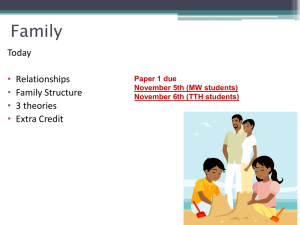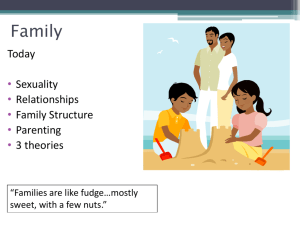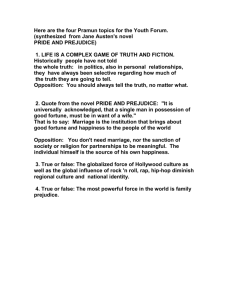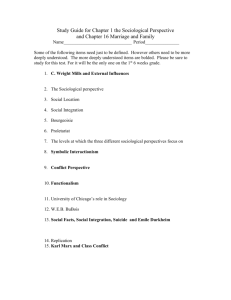Family
advertisement
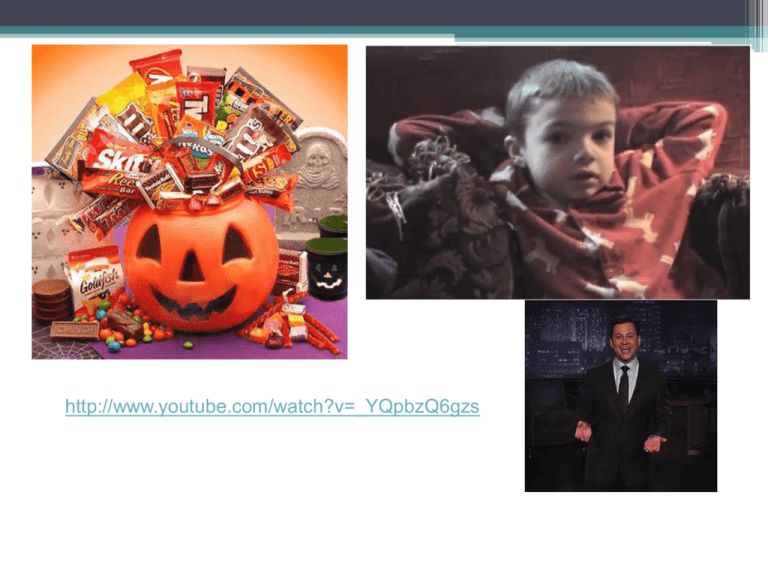
http://www.youtube.com/watch?v=_YQpbzQ6gzs Family Today • • • • Relationships Family Structure Parenting 3 theories Extra Credit Power Point (or Prezi.com) Option: Sociologists to Know Extra Credit 5 minutes Select a sociologist (sign up in class) 4 points possible Samples and details on website Due April 8th Tues/Thurs class, Due April 14th Mon/Wed class About Research Paper Due April 10th TTH 15 points 2 ½ - 3 pages typed Use scoring RUBRIC, this is how I grade the paper Use the OUTLINES on the website Weak Example Frustration-aggression hypothesis states that ethnic prejudice develop from people’s need to cope with the frustration in their daily lives (class notes). The Frustration-aggression hypothesis is illustrated by the Japanese Americans being sent to internment camps after the bombing of Pearl Harbor by Japan during World War II. Problem 1-definiton not in your own words or with quotation marks around it Problem 2- no researched details about the example Strong Example Frustration-aggression hypothesis states that ethnic prejudice starts from people needing find a group to blame for the frustration they feel (class notes). The Frustration-aggression hypothesis is illustrated by the Japanese Americans being sent to internment camps after the bombing of Pearl Harbor by Japan during World War II. When Japan bombed Pearl Harbor many people in our country developed an instant prejudice against the Japanese-American citizens living in United States. The American government assumed that the Japanese-Americans were spies and none of them could be trusted, so they confined the JapaneseAmericans to internment camps under Executive Order 9066 (Siasoco and Shmuel, 2011). The Japanese- Americans faced prejudice and discrimination in their communities. The United States government ruled that denying JapaneseAmericans their constitutional rights was necessary to protect America from espionage. Japanese Americans were forcibly removed from their communities, families, homes, businesses, and properties (Roberts, 2008) . Choice A: Norms. Describe norms, mores, and folkways as defined in your text. Research and provide three examples of norms that were once mores in our society, but over time have become folkways (or the other way around). Provide an analysis of why you think this change occurred. Choice B: Subcultures. Describe sub-cultures or counter cultures. Research and provide three examples of sub-cultures or counter cultures in American society. Why do they fit the definition of a sub-culture or counter-culture? What are some of the norms and values of each? Choice C: Race 100 years ago, sociologist W.E.B Du Bois said “The problem of the 20th century is the problem of the color line.” What is racism? Why is W.E.B Du Bois an important sociologist? Research and describe two modern day (recent) events related to racism. Choice D: Prejudice: Describe three of the four sociological approaches to explaining prejudice (Cultural Transmission, Group Identification Theory, Personality Theories, Frustration-aggression hypothesis) Research and provide a real-life example of each (from history, news, or one from personal experience, be specific and detailed). Which of these theories do you feel best explains discriminatory behaviors, why? Choice E: Illegal Immigration Research and analyze illegal immigration through each of the sociological perspectives. Conflict theory, Structural Functionalism, Symbolic Interactionism Papers that earn 15/15: 1. Followed the scoring rubric provided on the website and discussed in class 2. Answered the question with specific RESEACHED detailed examples (from studies, history, news, world events) 3. Did not have errors in spelling, grammar, or punctuation 4. Demonstrated a strong understanding of the concept TIP: Write it as if it is for someone other than your sociology teacher 5. Introduction had a strong, clear thesis previewing the 3 examples Finding your significant other 4 factors sociologists are interested in 1. Propinquity (spatial nearness) 2. Homogamy: tendency to chose a mate who is similar to you 3. Heterogamy: choosing a mate that is different than you Factors: hobbies, education, personality traits, spending habits, age, political beliefs, etc. 4. Endogamy: choosing a mate of the same racial, ethnic, or religious background 5. Exogamy: choosing a mate outside of your race, ethnicity, religion Defining Family • Social institution found in every human society • Two or more people, who consider themselves related by blood, marriage, or adoption Defining Family • Nuclear family: Parents and their children • Extended family: parents, children, other kin What changes do you think have occurred in the structure of families in the United States since the 1950’s? Has divorce increased, decreased, or stayed the same since the 1980’s? Number of divorces per 1,000 married women, age 15 and older Source: The National Marriage Project, State of Our Unions, 2010. Source: The National Marriage Project, State of Our Unions, 2010. Pros and Cons of Changes in Family Structure Answer questions in groups of 1-3 Changes in structures of U.S. families: 1. Delayed childbearing •Today 1 in 5 women are having their first baby after age 35 What are positive and negative aspects of this change? Changes in U.S. family structures 2. Not having children 14% of U.S. married couples never have children. Why? •Expenses •Career focus •Unstable relationships •Inability to have children Changes in U.S. family structures 3. Increased employment of married mothers 59% of married U.S. couples depend on two incomes About one in five children is cared for in day care centers. What are positive and negative aspects of this change? Nannies have become popular among upper-middle class parents. What are positive and negative aspects of this change? Cosby Show Changes in U.S. family structures 4. Increase in the number of children being raised by grandparents 6.5 million children o are being raised by grandparents or other relatives (U.S. Census Bureau) What are positive and negative aspects of this change? Changes in U.S. family structures 5. Increased divorce and blended families Modern Family Changes in U.S. family structures 6. Increased single-parent families One on One (Single dad and teenage daughter) Changes in U.S. family structures 7. Older age at 1st marriage Friends Sex and The City Changes in structures of U.S. families: Older age at 1st marriage U.S. men and women are staying single longer 1970 average age at marriage 2010 average age at marriage Men: 23 Men : 28 Women: 21 Women: 26 Changes in U.S. family structures 8. Increased interracial families The Willis Family from the TV Show The Jeffersons Changes in U.S. family structures 9. Increased cohabitation-couple living together that is not married Grey’s Anatomy Most unmarried partners: California, Alaska Least unmarried partners: Utah at 4% and Alabama 5% Changes in U.S. family structures 10. Less people getting married. Why? 1.Marriage must now compete with school career living with a partner having children outside of marriage self-fulfillment 2. Less of a need to marry 3. Time and money - children 4. Fearful of commitments and constraints Other changes U.S. family structure • Increased births to unmarried women • Increase in families with same-sex parents • Increase in families with adopted children Has teenage pregnancy increased, decreased, or stayed the same since 1990’s? Teenage pregnancy has decreased Source: Center for Disease Control and Prevention http://www.cdc.gov/nchs/products/hestats.htm Parenting Punishment = penalty for misbehavior Discipline= method of teaching a child right from wrong View SuperNanny Clip Parenting: Discipline Techniques 1. Be a positive role model. 2. Set rules and consequences. 3. Encourage and reward good behavior. 4. Create charts. 5. Give time-outs. 6. Spanking Which of these techniques do you think are effective? Which do you think are ineffective? Parenting Amy Chua’s article “Why Chinese Mothers are Superior” Underline 3 points that you agree or disagree with Underline any parenting techniques that you experienced or use as a parent 1. What did you underline and why 2. Do you agree with the author’s parenting style? Why or why not? 3. What parenting techniques do you think are best? Chua family From Ms. Chua's album: 'Mean me with Lulu in hotel room... with score taped to TV!' Structural Functionalist Perspective Family is the back bone of society – Replenishes population – Socializes children – Provides emotional and physical care Conflict Perspective Focuses on power distribution in marriages • Why do women take husbands last name? • Why do children take father’s last name? Symbolic Interactionist Perspective Look at social meanings of divorce, single parenthood, and cohabitation • “Visitation rights” • “Single mom” • “Living in sin” Coming up Religion and Education Read Ch 12: 284-287, 297-299, and article on class website Misconceptions About Islam Sign up for Sociologist To Know extra credit Extra Credit Important Sociologists • 5 minute Power Point Presentation • Select a sociologist. Describe the following: brief background of their life, 2 major contributions to sociology, how is their work relevant today? • 4 points possible • Present next week • Choose the sociologist in class today by signing up View sample on website Silent Dialogue Partner Activity Purpose of the activity: 1. Develop critical thinking skills (there is no right or wrong answer, no right or wrong question to pose). The goal is to ask your partner a question that will invite them to look at their own thoughts in a deeper manner 2. Allow shy/quiet students share their thoughts 3. Allow students to be the ones asking the questions instead of the teacher 4. Allow students to get feedback from peers instead of the teacher 5. Allow the teacher to assess the background knowledge students have on the topic (what do you already know about changes in family structure?) What changes do you think have occurred in the structure of families in the United States since the 1950’s? Partner activity 1. Answer the question above. Write NEATLY Example: “One way I think families have changed since the 1950’s is ____” 2. When you hear the buzzer, pass your paper to your partner 3. Read their statement and write an OPEN-ENDED thought provoking question for your partner that requires them to think about the topic more deeply or look at it in a different way 4. When you hear the buzzer, switch papers and respond to you partner’s question thoughtfully. 5. When you hear the buzzer switch papers and read the response Write your names on both papers, turn into red folder at the end of class for your participation points for today Defining Family • Family of orientation is the family in which a person grows up (your parents and siblings) • Family of procreation is the family formed when a couple’s first child is born (your partner and children).
